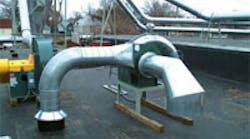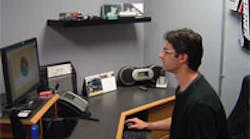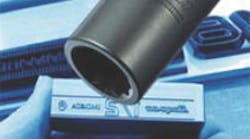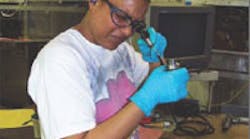The ScanScope system for pathology work operates using Heidenhain encoders.
Virtual Microscopy, or the creation, management and analysis of digital slides via a computer monitor, helps pathologists overcome many of the obstacles associated with using glass microscope slides. At the forefront of this technology, Aperio Technologies Inc. (www.aperio.com) produces a system that uses an innovative linescanning method for the digitization of pathology. The system would not have been possible without special linear encoders for utlraprecise positioning — similar encoder technology found in many of today's machine tools.
Aperio's ScanScope line-scanning system uses a linear-array detector in conjunction with specialized motioncontrol components, microscope objective lens and customized optics to capture a small number of contiguous overlapping image stripes. Within the system, three Heidenhain Corp. (www.heidenhain.com) linear encoders maintain extremely constant velocity during line-scanning, and are instrumental in ensuring uniform focus across a slide.
Unlike the stop-and-go nature of conventional image tiling, lineararray scanning relies on continuous motion, making it ideal for rapid slide digitization. "With this system, the pathologist should never need to go back to the glass slide or look at it through a microscope because our digital version provides all the necessary information on his or her computer," says Greg Crandall, vice president of engineering at Aperio.
System image quality relies on uniform constant velocity, and any changes in velocity would cause the image to appear smudged or could introduce artifacts. Small nanomotors, a Heidenhain 1-micron Lida 400 encoder on the Y axis and a tenthmicron Heidenhain encoder on the X axis maintain constant velocity point-to-point in Aperio's system. "It was important that we coupled our motor with an extremely highresolution feedback-loop encoder, and Heidenhain fit the bill," says Crandall. Lida 400 encoders sport a grating pitch of 20 microns and can be used in any application that calls for precise positioning in tight spaces. While its scanning head measures only 12 mm, the encoder provides a scanning area of 14.5 mm2. Crandall says his company tried other encoders, but discovered he got better performance and easier installation at less cost with the Heidenhain encoders.
Aperio also incorporates a Heidenhain encoder for the ScanScope's focusing function. The system makes adjustments on-the-fly to accommodate the subtle but significant topology changes inherent in tissue specimens.
Another nanomotor and 50-nanometer Lida 400 encoder focus the system's Z axis and adjust focus from one scan line to the next, approximately 1,000 times more frequently than image-tiling systems. This produces a digital slide that is perfectly focused everywhere and free of optical aberrations.








